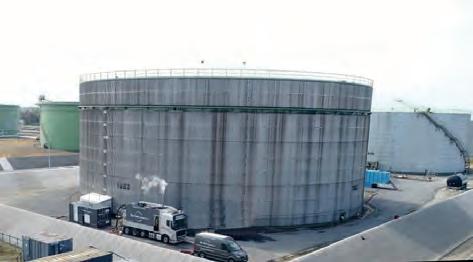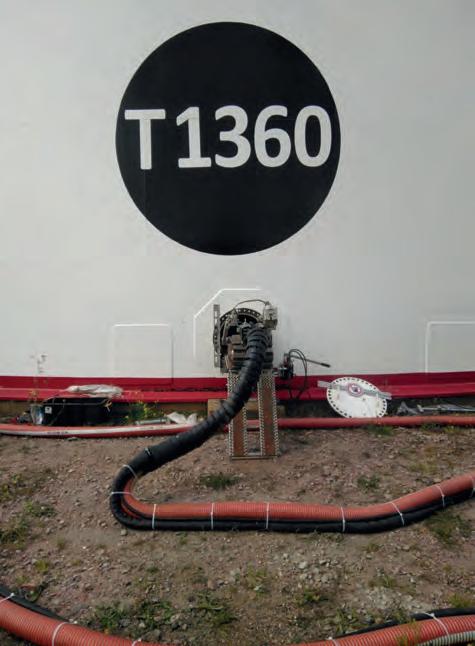
7 minute read
Robotic revolution
Fintan Duffy, Re-Gen Robotics,
Northern Ireland, considers how robotic cleaning of tanks can improve safety and reduce the need for workers to enter tanks.
Statistics coming out of the US tank cleaning sector are concerning. Approximately 2.1 million workers enter permit confined spaces annually and on average two workers die every single week in accidents related to confined spaces. Sadly, around 60% of those confined-space fatalities are would-be rescuers, leading to industry initiatives calling for an end to confined space entry in the US by 2025.
New benchmarks for safe tank cleaning are being reached with 100% no man entry systems. Robotic tank cleaning services can include fixed roof, floating roof, heavy fuel oil, and coned floor tank cleaning. Fully submersible robots operate in the most inhospitable environments. With specialised access cranage, remote camera systems, and engineering expertise, any size or shape of oil, gas or chemical tank can be cleaned.
Robotic equipment is dexterous and versatile and can navigate and work in its environment using multiple sensors and washers, while the robot's operator remains in a state-of-the-art control room, protected from hazardous conditions. Cleaning schedules are ultra-precise because of the highly standardised and self-contained tank telemetry process that allows clients to accurately estimate the amount of time needed for cleaning any given tank. Advantages for tank terminals include fixed costs, reduced paperwork and permits, and no requirement for capital outlay and standby rescue teams. To date, Re-Gen Robotics has been responsible for eliminating over 11 000 hours of confined space entry cleaning in oil and gas tanks. More than 40 tanks consisting of white oil, black oil, and distillate tanks in gas plants have been cleaned for oil majors such as Shell, P66, Valero, ExxonMobil, and Vermilion among others.
The following case studies demonstrate the variety of tanks and materials that robotic equipment can clean, the challenges encountered, the solutions implemented, and the benefits conveyed.
Shell UK Oil Products Ltd, Shell Haven Terminal
Re-Gen Robotics was commissioned by Shell UK Oil Products Ltd to clean two 30 m floating roof, Jet A1 fuel storage tanks at the Shell Haven Terminal in the UK.
Challenge
Both tanks had a resin lining applied to the floor and 1 m up the tank walls.

Figure 1. A remotely controlled Zone Zero certified ATEX robot entering an oil tank.
Figure 2. Re-Gen Robotics provide a complete system to clean a tank without the need for any scaffolding, cranage, or vacuum/jetting. Solution

Magnetic tracks were removed from service for lined tanks and plain rubber tracks were fitted to the robot to protect the resin flooring.
Facts
Around 12 – 14 t of sludge was removed from each tank, with 2 t of water utilised for each tank. The number of robotic hours onsite were 90 per tank, and the number of man hours eliminated onsite were 448 per tank. It is estimated that a manned cleaning would have taken eight days, whilst the robotic cleaning took just three. In addition, less paperwork and permits were necessary and there was no requirement to spade tanks or for a standby rescue team. Scaffolding, cranage and vacuum jetting was also provided.
Conclusion
Overall feedback from Shell was very positive. These were the first tanks to be completely cleaned and inspected by Shell, worldwide, without the need for human presence in the tanks. Following this initial project, Re-Gen Robotics has been commissioned to clean more tanks at the Shell Haven Terminal. Shell has committed to end manned tank cleaning across its operations by the end of 2022.
Vermilion Gas Terminal
Re-Gen Robotics was commissioned to clean two 15 m tanks at a gas terminal that refines and purifies gas from a gas field in the west coast of Ireland. The first tank scheduled to be cleaned contained methanol and the second tank contained condensate, a low-density mixture of hydrocarbon liquids present as gaseous components in raw natural gas.
Challenges
The tanks were resin lined and contained a large amount of internal furniture including aluminium legs, skim arms and floating pontoons. Entry manholes were raised slightly higher than standard tanks, and there was a great deal of piping situated on the ground around the tanks’ exteriors.
Initial inspection verified that the height of the tank was considerably lower than most tanks. Therefore, it would be necessary to restrict the height of the telescopic camera bracket.
Solutions
Plain rubber tracks were fitted to the robot to protect the resin flooring, and an offset suction head was deployed to clean around heating coils.
The low-profile tool can access under pipes and has the ability to remove waste from below floor level. It can operate offset on the left, right, and straight-ahead positions. This tool alone can decrease tank cleaning time by 10 – 12%.
It was noted that a portable raised platform would be required to allow the robot to pass freely over the exterior pipework, to meet the manhole entry ramp. The platform was supplied by the client and was also used for the second tank clean.
Arrangements were immediately put in place to fit rubber stoppers around the ATEX camera and restrict the height of the camera bracket with a length of chain.
Facts
Re-Gen Robotics notes that 7 t of sludge was removed from each tank, with 1.5 t of water utilised for each tank. The number of robotic crew hours onsite were 45 per tank, and the number of man hours eliminated onsite were 280 per tank. It is estimated that a manned cleaning would have taken five days, whilst the robotic cleaning took one and a half days. Once again, less paperwork and permits were necessary, there was no requirement to spade tanks or for a standby rescue team, and no requirement for capital outlay.
Conclusion
The speed and efficiency of the tank cleans exceeded Vermilion’s expectations, by finishing ahead of schedule and by significantly reducing the amount of tank downtime. Re-Gen Robotics continues to clean tanks for Vermilion.
Phillips 66 Humber Refinery
Re-Gen Robotics carried out the first no man entry crude oil tank clean for Phillips 66 Ltd’s Humber Refinery. Approximately 20% of all UK petroleum products come from the Humber Refinery. Re-Gen Robotics was commissioned to clean a 50 m fixed roof, cone-up floor crude oil (black) tank.
Challenges
Exact tank furniture details and volume of sludge were unspecified. The volume of waste inside the tank was understood to be approximately 135 t and the product temperature was ambient. The tank also had numerous steam coils, which the robot was required to navigate around.
Solutions
The robot is fully submersible and has an auger system located at the front which breaks down heavy sludge, without the requirement to use water, thereby generating less waste. The sludge was then extracted by an ADR certified jet/vac tanker with a 4800 m3 per hour vacuum capacity. The robot uses an offset suction head to clean around the heating coils.
Facts
536 t of sludge was removed from each tank, with 92 t of water utilised. The number of robotic crew hours onsite were 1520, and the number of man hours eliminated onsite were 12 160. It is estimated that a manned cleaning would have taken 95 days, whilst the robotic clean took 43. Less paperwork and permits were necessary, there was no requirement to spade tanks or for a standby rescue team, and no requirement for capital outlay.
Conclusion
Phillips 66 noted that the no man entry tank clean system could be adapted to suit its individual needs and timeframes. Following the initial contract, Re-Gen Robotics was commissioned to clean a further three tanks at the site and has recently been included in the tender process for 14 tanks over the next three years.
Summary
Ignoring safety critical maintenance and asset performance optimisation can lead to enormous loss; damage to infrastructure; loss of production time; public investigations; environmental damage; fines; and can have a very negative impact on a company's brand values and reputation.
People can make mistakes in high stress situations, even when they are well meaning, so instead of trying to predict why and when accidents could happen, terminal operators can eradicate the problem by taking people out of tanks altogether. Inherent safety can be achieved by avoiding hazards completely, rather than trying to control them, and this is where massive cost and time savings can be made.

Figure 3. Re-Gen Robotics kit stationed at Shell Haven Terminal.
Figure 4. A robot fits through standard 600 mm manway using an externally fixed hydraulic ramp.










